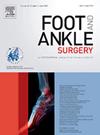Open and all-inside arthroscopic Brostrom-Gould for chronic lateral ankle instability: A comparative analysis of surgical outcomes and learning curves
IF 1.9
3区 医学
Q2 ORTHOPEDICS
引用次数: 0
Abstract
Objective
The purpose of this study was to investigate and compare the learning curve and clinical outcomes of all-inside arthroscopic and open techniques in the treatment of chronic lateral ankle instability (CLAI).
Method
This was a retrospective cohort analysis of 100 consecutive patients who received all-inside arthroscopic or open Brostrom-Gould surgery. These patients with CLAI were all surgically treated by the same surgeon. We applied the CUSUM analysis to assess the surgeons' learning curves, determine the cut-off point, and subsequently divide the patients into learning and proficiency groups. We recorded and compared baseline data, the preoperative and postoperative clinical function scores (AOFAS, K-P, and Tegner scores), VAS scores, time to full weight-bearing, surgery-related parameters (operation time, and postoperative hospital stays), and complications for both surgical methods during their learning and proficiency phases.
Result
The CUSUM analysis identified a learning curve cutoff at 12 cases for open surgery and 22 cases for arthroscopic surgery. In the open surgery group, significant differences were observed in operation time between the learning and proficiency phases (P < 0.05). However, no significant differences were found in clinical function scores and postoperative full weight-bearing time. Similar trends were seen in the arthroscopic surgery group, with significant improvements in operation timeand postoperative hospitalization time in the proficiency phase compared to the learning phase (P < 0.05). However, no significant differences were found in clinical function scores between either surgical method's learning and proficiency stages. Additionally, when comparing the two surgical approaches at the same stage, significant differences emerged in VAS scores, postoperative full weight-bearing time, operation timeand postoperative hospitalization time (P < 0.05), with the arthroscopic technique showing advantages in reduced postoperative discomfort and faster recovery times.
Conclusion
Although arthroscopic surgery takes longer to achieve proficiency, it offers the advantages of reduced postoperative discomfort and faster recovery times during both the learning and proficiency phases while achieving comparable clinical outcomes.
慢性外侧踝关节不稳的开放式和全内侧布鲁斯特罗姆-古尔德关节镜手术:手术效果和学习曲线的比较分析。
研究目的本研究的目的是调查和比较在治疗慢性外侧踝关节不稳(CLAI)时,全内侧关节镜和开放式技术的学习曲线和临床结果:这是一项回顾性队列分析,对连续接受全关节镜或开放式Brostrom-Gould手术的100名患者进行了分析。这些 CLAI 患者均由同一外科医生进行手术治疗。我们采用 CUSUM 分析法评估外科医生的学习曲线,确定分界点,然后将患者分为学习组和熟练组。我们记录并比较了两种手术方法在学习阶段和熟练阶段的基线数据、术前和术后临床功能评分(AOFAS、K-P 和 Tegner 评分)、VAS 评分、完全负重时间、手术相关参数(手术时间和术后住院时间)以及并发症:CUSUM分析确定了学习曲线分界线,即开放手术组为12例,关节镜手术组为22例。在开放手术组中,学习阶段和熟练阶段的手术时间存在显著差异(P 结论:虽然关节镜手术需要更长的时间,但在学习阶段和熟练阶段,两种手术方法的手术时间均存在显著差异:虽然关节镜手术需要更长的时间才能达到熟练程度,但它在学习阶段和熟练阶段都具有减少术后不适和加快恢复时间的优势,同时还能获得相似的临床效果。
本文章由计算机程序翻译,如有差异,请以英文原文为准。
求助全文
约1分钟内获得全文
求助全文
来源期刊

Foot and Ankle Surgery
ORTHOPEDICS-
CiteScore
4.60
自引率
16.00%
发文量
202
期刊介绍:
Foot and Ankle Surgery is essential reading for everyone interested in the foot and ankle and its disorders. The approach is broad and includes all aspects of the subject from basic science to clinical management. Problems of both children and adults are included, as is trauma and chronic disease. Foot and Ankle Surgery is the official journal of European Foot and Ankle Society.
The aims of this journal are to promote the art and science of ankle and foot surgery, to publish peer-reviewed research articles, to provide regular reviews by acknowledged experts on common problems, and to provide a forum for discussion with letters to the Editors. Reviews of books are also published. Papers are invited for possible publication in Foot and Ankle Surgery on the understanding that the material has not been published elsewhere or accepted for publication in another journal and does not infringe prior copyright.
 求助内容:
求助内容: 应助结果提醒方式:
应助结果提醒方式:


